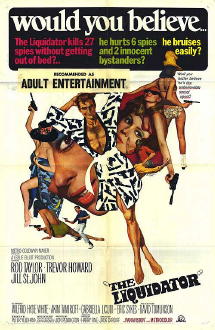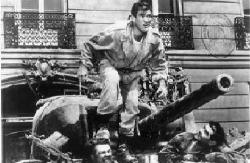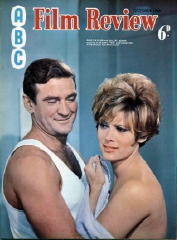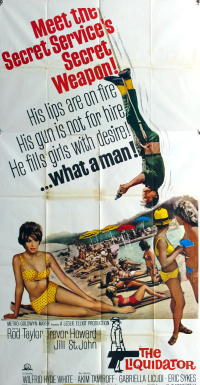Mon 7 Jul 2008
Movie Review – THE LIQUIDATOR (1965).
Posted by Steve under Characters , Reviews , Suspense & espionage films[2] Comments
THE LIQUIDATOR. MGM, 1965. Rod Taylor, Jill St. John, Trevor Howard, Wilfred Hyde-White. Song over opening credits: sung by Shirley Bassey. Based on the novel of the same name by John Gardner. Director: Jack Cardiff.

Anti-hero secret agent Boysie Oakes has come up before on this blog, back when I read and reviewed Understrike, a later book in the series. That’s when I also listed all of the books in the series, so I needn’t do it here.
But I will repeat myself a bit by describing how I saw Mr. Oakes back then:
I also wondered about how Mr. Oakes got into the spy business in the first place, if he’s that inept and that much of a coward. Well, wonder no more, Mr. Lewis. The opening scene of the movie version of The Liquidator, filmed in black-and-white (with the rest of the movie in color), tells us exactly that. In the closing days of World War II, during the liberation of Paris, Boysie Oakes (Rod Taylor) accidentally saved the life of a British agent named Mostyn. See below and to the right:

Mostyn (Trevor Howard), never one to forget favors like that, but also not knowing how accidental his rescue was, calls on Boysie much later on to fill a new position in his Department, that of assassin, to eliminate those embarrassing people (double agents and the like) who would provide the press with more scandals, either by defecting or being arrested before they could defect.
Tempted by the promises of a mid-60s Hugh Hefner life of luxury when not working, even before he knows what “working” actually means, Boysie accepts. Bad move. How does he get out of actually doing the work? In the most delightfully engaging way – assuming of course you agree that the victims actually need to be, um, liquidated.

There is some satire involved here, as well as a slight touch of spoofery, and by this time half the movie is over. Of course there is another hour to fill, and with beautious Jill St. John (as Iris, Mostyn’s right-hand assistant) on hand to accompany Boysie on a strictly unauthorized trip for two to the Riviera, you’d think it would be filled most handsomely.
Not so. The people who put out the film thought they needed a plot, but the plot they give us is pure pap. Things do not go nearly as well as Boysie had planned. First he’s kidnapped (amusingly before anything serious happens in the bedroom), then released and/or allowed to escape, then sent off on a fool’s mission to do some serious damage back in the UK.

I’ve not read The Liquidator, the book, but at least one source says the movie people actually followed the book fairly closely. Perhaps they did, but they missed something, that something perhaps being that in spite of the movie being largely a spoof – which it definitely is until the shooting starts …
That’s it. That’s exactly when things started going wrong. Right then, when the movie people began to make a straight (but still more than a little goofy) action picture out of what until then was a mild and gentle satirical poke at Mr. Bond.
One other note. In the book I read, as you may recall from the review excerpt above, Boysie was described as being a coward.
That’s hard to play on the screen, so that part was downplayed, or so it seems to me. Rod Taylor simply plays Boysie as a good-natured chap, a fellow who’s rather inept (as also previously described) and gets sick in airplanes (and you know where that will lead) but this is about as far into that direction the movie goes.
This was the only film version of the character that was ever made.
July 8th, 2008 at 11:41 am
Is it out on DVD yet? I have had the soundtrack since I was a kid but have never seen the movie. It seems to have fallen into the same black hole as Rod’s DARKER THAN AMBER.
July 8th, 2008 at 12:50 pm
Lee —
No, there aren’t any official releases, but a quick check of the Internet shows that you can get a copy of either one without too much difficulty.
— Steve